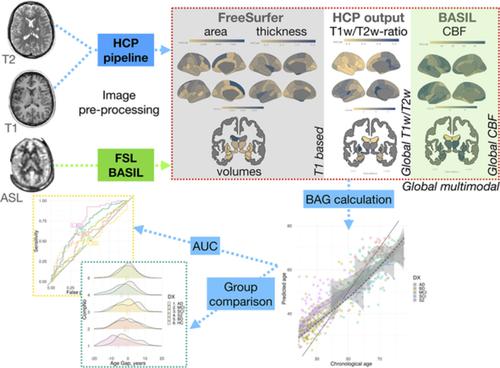当前位置:
X-MOL 学术
›
Hum. Brain Mapp.
›
论文详情
Our official English website, www.x-mol.net, welcomes your
feedback! (Note: you will need to create a separate account there.)
Multimodal imaging improves brain age prediction and reveals distinct abnormalities in patients with psychiatric and neurological disorders
Human Brain Mapping ( IF 3.5 ) Pub Date : 2020-12-19 , DOI: 10.1002/hbm.25323 Jaroslav Rokicki 1, 2 , Thomas Wolfers 1, 2 , Wibeke Nordhøy 3 , Natalia Tesli 1 , Daniel S Quintana 1, 2, 4 , Dag Alnaes 1 , Genevieve Richard 1 , Ann-Marie G de Lange 1, 2, 5 , Martina J Lund 1 , Linn Norbom 1, 2, 6 , Ingrid Agartz 1, 4, 6, 7 , Ingrid Melle 1 , Terje Naerland 4 , Geir Selbaek 8, 9, 10 , Karin Persson 8 , Jan Egil Nordvik 11 , Emanuel Schwarz 12 , Ole A Andreassen 1, 4 , Tobias Kaufmann 1 , Lars T Westlye 1, 2, 4
Human Brain Mapping ( IF 3.5 ) Pub Date : 2020-12-19 , DOI: 10.1002/hbm.25323 Jaroslav Rokicki 1, 2 , Thomas Wolfers 1, 2 , Wibeke Nordhøy 3 , Natalia Tesli 1 , Daniel S Quintana 1, 2, 4 , Dag Alnaes 1 , Genevieve Richard 1 , Ann-Marie G de Lange 1, 2, 5 , Martina J Lund 1 , Linn Norbom 1, 2, 6 , Ingrid Agartz 1, 4, 6, 7 , Ingrid Melle 1 , Terje Naerland 4 , Geir Selbaek 8, 9, 10 , Karin Persson 8 , Jan Egil Nordvik 11 , Emanuel Schwarz 12 , Ole A Andreassen 1, 4 , Tobias Kaufmann 1 , Lars T Westlye 1, 2, 4
Affiliation

|
The deviation between chronological age and age predicted using brain MRI is a putative marker of overall brain health. Age prediction based on structural MRI data shows high accuracy in common brain disorders. However, brain aging is complex and heterogenous, both in terms of individual differences and the underlying biological processes. Here, we implemented a multimodal model to estimate brain age using different combinations of cortical area, thickness and sub‐cortical volumes, cortical and subcortical T1/T2‐weighted ratios, and cerebral blood flow (CBF) based on arterial spin labeling. For each of the 11 models we assessed the age prediction accuracy in healthy controls (HC, n = 750) and compared the obtained brain age gaps (BAGs) between age‐matched subsets of HC and patients with Alzheimer's disease (AD, n = 54), mild (MCI, n = 90) and subjective (SCI, n = 56) cognitive impairment, schizophrenia spectrum (SZ, n = 159) and bipolar disorder (BD, n = 135). We found highest age prediction accuracy in HC when integrating all modalities. Furthermore, two‐group case–control classifications revealed highest accuracy for AD using global T1‐weighted BAG, while MCI, SCI, BD and SZ showed strongest effects in CBF‐based BAGs. Combining multiple MRI modalities improves brain age prediction and reveals distinct deviations in patients with psychiatric and neurological disorders. The multimodal BAG was most accurate in predicting age in HC, while group differences between patients and HC were often larger for BAGs based on single modalities. These findings indicate that multidimensional neuroimaging of patients may provide a brain‐based mapping of overlapping and distinct pathophysiology in common disorders.
中文翻译:

多模态成像改善了大脑年龄预测并揭示了精神和神经疾病患者的明显异常
实际年龄与使用大脑 MRI 预测的年龄之间的偏差是整体大脑健康的假定标志。基于结构 MRI 数据的年龄预测在常见脑部疾病中显示出很高的准确性。然而,大脑衰老是复杂和异质的,无论是个体差异还是潜在的生物过程。在这里,我们实施了一个多模态模型来估计大脑年龄,使用皮质面积、厚度和皮质下体积、皮质和皮质下 T1/T2 加权比率以及基于动脉自旋标记的脑血流量 (CBF) 的不同组合。对于 11 个模型中的每一个,我们评估了健康对照(HC,n= 750) 并比较了年龄匹配的 HC 子集与阿尔茨海默病 (AD, n = 54)、轻度 (MCI, n = 90) 和主观 (SCI, n = 56)患者之间获得的脑年龄差距 (BAG )认知障碍、精神分裂症谱系(SZ,n = 159)和双相情感障碍(BD,n= 135)。当整合所有模式时,我们发现 HC 的年龄预测准确度最高。此外,两组病例对照分类显示使用全局 T1 加权 BAG 对 AD 的准确性最高,而 MCI、SCI、BD 和 SZ 在基于 CBF 的 BAG 中显示出最强的影响。结合多种 MRI 模式可以改善大脑年龄预测,并揭示精神疾病和神经疾病患者的明显偏差。多模式 BAG 在预测 HC 的年龄方面最准确,而基于单一模式的 BAG 患者和 HC 之间的组差异通常更大。这些发现表明,患者的多维神经影像学可能提供基于大脑的常见疾病重叠和不同病理生理学的映射。
更新日期:2020-12-19
中文翻译:

多模态成像改善了大脑年龄预测并揭示了精神和神经疾病患者的明显异常
实际年龄与使用大脑 MRI 预测的年龄之间的偏差是整体大脑健康的假定标志。基于结构 MRI 数据的年龄预测在常见脑部疾病中显示出很高的准确性。然而,大脑衰老是复杂和异质的,无论是个体差异还是潜在的生物过程。在这里,我们实施了一个多模态模型来估计大脑年龄,使用皮质面积、厚度和皮质下体积、皮质和皮质下 T1/T2 加权比率以及基于动脉自旋标记的脑血流量 (CBF) 的不同组合。对于 11 个模型中的每一个,我们评估了健康对照(HC,n= 750) 并比较了年龄匹配的 HC 子集与阿尔茨海默病 (AD, n = 54)、轻度 (MCI, n = 90) 和主观 (SCI, n = 56)患者之间获得的脑年龄差距 (BAG )认知障碍、精神分裂症谱系(SZ,n = 159)和双相情感障碍(BD,n= 135)。当整合所有模式时,我们发现 HC 的年龄预测准确度最高。此外,两组病例对照分类显示使用全局 T1 加权 BAG 对 AD 的准确性最高,而 MCI、SCI、BD 和 SZ 在基于 CBF 的 BAG 中显示出最强的影响。结合多种 MRI 模式可以改善大脑年龄预测,并揭示精神疾病和神经疾病患者的明显偏差。多模式 BAG 在预测 HC 的年龄方面最准确,而基于单一模式的 BAG 患者和 HC 之间的组差异通常更大。这些发现表明,患者的多维神经影像学可能提供基于大脑的常见疾病重叠和不同病理生理学的映射。











































 京公网安备 11010802027423号
京公网安备 11010802027423号